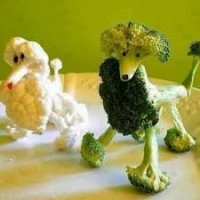The Low Down on Bacteria
It seems the more we look the more we come to realise how little we actually know for sure. That’s not a bad thing on the whole because it keeps us looking.
My own investigation has come up with the conclusion that the food we eat and how we eat it, is essential in determining what sort of microbiota we harbour, irrespective of whether we are human, canine or camelid.
The microbiota governs health and the gut microbiome is the largest living intelligence an individual possesses. This posting will look at how this knowledge influences our choice of foods in relation to how we feed our dogs and cats.
The debate over raw feeding dogs and cats will most likely smoulder along for quite some time. There is no convincing those who have decided one way or the other but for those still searching there is much to be discussed and learned.
In the area of best diets for dogs and cats there are few absolutes. There are however, many attempts to persuade or dissuade using fashionable terminology that becomes increasingly confusing to well meaning pet owners seeking accurate information.
Here are some terms that I find have become corrupted
‘good quality’, ‘natural’, ‘balanced’, ‘real food’, ‘organic’, ‘holistic’ and the good old ‘scientifically formulated’ as if there really is anything truly scientific about putting food into mouths. In fact in the hands of advertising companies pretty much everything you read on the packet is misleading jargon devised to erode consumers confidence in their own common sense.
Cooked foods provide nutrients that are good but inevitably altered and diminished by cooking. Humans are the only species on the planet to cook their food and no other animals require cooked food. Dogs and cats will eat it because they are co-dependent on humans and have adapted to tolerate these foods over many centuries. Some dogs prefer cooked food and some older or very ill dogs tolerate cooked food better at times. It takes more energy to digest raw food which is why advanced cancer cases and old aged animals can benefit from cooked foods and obese younger animals will lose weight on raw diets.
The benefits and reasons for feeding raw diets have been widely described elsewhere.
There is also a lot of worry and uncertainty surrounding the issue of bacteria in foods. Dogs especially have evolved to deal with bacteria that we could not tolerate as they drag around the trophy three weeks dead rabbit or possum carcass. Cats are much fussier and prefer fresh kill unfortunately for birds and bird lovers and gardeners. They do however devour the entire prey, bacteria and all. The low down is that the vast majority of bacteria are beneficial in a species appropriate diet. Cats can eat raw mice, I don’t think we ever should for example.
The universal answer to all enquiries regarding what constitutes best feeding practice for pets is that it depends upon the availability and affordability of options and the addition of some fresh species appropriate whole foods to the diet.
As a race we no longer hunt and gather our own food fresh from nature and with the dependency on processed and stored foods it can be difficult to provide fresh food to animals when any leftovers from meat works are rendered into cooked petfood. Butchers are less likely these days to be primary providers of whole animals as most of the dressing is done before they are employed as retailers. It is certainly worth asking your butcher about the availability of scraps and offcuts nevertheless.
Any attempt to introduce any quantity of fresh whole foods (ie; not packeted or tinned but fresh from the butcher or the earth) will bring enormous benefit to even the lowest quality and cheapest processed foods available. In fact the addition of even the occasional fresh green vegetable or fresh meaty bone will bring profound benefit to the lives and health of any dog or cat and even owners on very limited budgets can help their pets in this way. There is also a growing market for processed fresh pet meats, which are often reasonable alternatives as long as there is also a fresh bone component. This is most important and constitutes one of the only truly valid ‘balances’ required, the calcium to phosphorus ratio. No more than 20% bone and no less than 10% to that of total meat. Not surprisingly this equates to a whole, well nourished prey.
In my research for this posting I have attended webinars and read many articles from varied sources. Thirty years ago veterinarians were discussing the perils of home made diets for dogs and this arose largely due to the failure to feed a meat/bone ration. Bone must not be cooked (unless used to make a broth) and was often neglected as an essential ingredient in homemade diets.
Some points worthy of consideration:
+ every feeding option available potentially has some disadvantages so having access to current and accurate information is imperative to making informed choices. There are some excellent resources available including The Answer Vet
+ It is not sufficient to say that a food provides all the essential nutrients. A pill or a drink can essentially claim that fact but is not a behaviourally satisfying or species appropriate diet.
+ As more information becomes available about the importance of the microbiome we will better understand that the gut-brain axis is not switched to optimum settings for health in animals by simply providing nutrients alone. What our animals need is environmental enrichment of social contact, eating in groups, crunching species appropriate diets that satisfy emotional and behavioural development that mashes and kibble cannot replace.
+Dogs and cats have teeth.
+ The number of dogs presenting to my practice for gut related problems is testament to the fact that we need to focus more on best feeding practices which includes chewing and getting behavioural needs met along with provision of essential nutrients
A rapidly emerging field of interest (nutrigenomics) involves understanding what the body (microbiome) actually does to and with the food we feed our pets.
This is currently better researched in ruminant physiology.
A good example of this includes the discovery that cows fed on pastures of equal omega3 content produce different levels of high quality fatty acids (CLA) in their food products (meat and milk) on mixed grass pastures than single (equivalent) crops. The gut flora (rumen in this case) is more productive and apparently does exciting things with the environmental and dietary enrichment of mixed grass pastures.
This is quite an amazing finding that demonstrates the innate intelligence in biological systems that we cannot ever hope to replicate. I am certain that it is not unique to ruminants and we will be hearing about a lot of ‘new’ discoveries in this area soon whereby the bacteria augment the health of the host in ways we have not yet fully realised. It also reminds us clearly of the health benefits of pasture fed meat over grain and feedlot.
A topic of major concern to many people looking at raw diets for pets is that of parasites. As vets we were very well taught about parasitology but not in the context of feeding raw meaty diets to dogs. Even now it takes a bit of searching to get the low down on why freeze dried probiotics are effective and freezing meat kills parasites dependent on the length of freeze time.
It can be confusing and easy to see why many people opt for processed foods but an increasing number of clients to my practice who have had difficulties managing their own health have come to care about the comparisons between foods for ourselves and our animals.
Reasons to care include, not spending hard earned money on ineffective or inactive probiotics, not feeding contaminated offal or wild game to dogs without precautions and keeping people and animals safe from potential zoonoses (animal diseases infective to humans). These risks are minimised by knowledge.
Some items I have been asked about recently are presented here.
Fresh frozen green tripe (cow stomach lining) appears to be a reasonable way to source the benefits of this highly nutritious food as, apart from being slightly less smelly, it appears the bacterial and probiotic benefits are also retained. Freezing wild rabbits, marsupials, wild ducks and birds, wild goat or wild buffalo for three weeks will kill toxoplasmosis and hydatids if they happen to be present and since it can be very hard to tell if they are, a good practice to employ if you are feeding these wild game foods and have a large enough freezer. Not all wild animals will carry these parasites but with encroaching urban populations and feral cats, the risk of wild hosts picking these up from infected dog and cat faeces increases.
Trichinella is a dangerous worm that is resistant to freezing and is a risk in feeding raw or undercooked wild pig (and certain Atlantic fish if Northern Hemisphere). Rare exceptions such as these fuel fear over raw feeding practices. Being informed avoids these perils. The flip side to this is the most recent misinformation about raw feeding putting dogs and families at risk of salmonellosis when the majority of documented cases of food poisoning with salmonella actually come from cooked and processed kibble diets and poor food hygiene practices.
Suffice to say that good hygiene practice should attend all food preparation irrespective of the diet fed and bacteria on the whole are extremely beneficial and essential to good health.
I am reminded here of a fantastic video on Lateline I saw recently about how we are now curing intractable bowel disease using a transplant of healthy faeces.
Here is a quote from a veterinary colleague
“I recently got a litter of premature puppies better from ‘atonic guts’ as diagnosed by a specialist after ultra sounding the 2 week old pups who were fading. I got the breeder to make a soup of faeces from her most healthy, non chemically treated dogs, and give it orally to the pups and they were all back to normal in a day.”
Incidentally, homeopaths have been curing myriad ailments with bowel nosodes (medicines made from bacteria from human intestinal tract) since they were pioneered in the 1920’s.
Bacteria were the first inhabitants on Earth and have built elaborate cities from all walks of life including us and the other animals.
The low down is that bacteria still rule the world. If we feed them and keep them optimally happy then we get the benefit of maximum health and vitality as tenants of their elaborate biological edifices.
We are just renting space on Earth from them temporarily for our own purposes.


April 14th, 2020 at 7:06 am
Thank you Dr Pearson interesting article and has given me a better understanding and knowledge to help my beautiful girl Skye 9yr Blue Heeler ….Skye has come along in leaps and bounds since being treated by you… thank you sooooo much for giving us hope and joy back into our lives. ….we give thanks and gratitude to you…Judi&Skye
October 18th, 2016 at 5:08 am
Very interesting article Saranyu, wonderful to see more information being presented on such a fascinating topic. I’d love to learn more on the possible effects on dogs microbiome and issues such as fear/anxiety. In the meantime, I’ll continue researching and feeding a diverse diet that hopefully supports a healthy colony of gut bacteria. 🙂
January 17th, 2016 at 3:39 am
Hi Saranyu, what an excellent, well researched, interesting article, Clare.